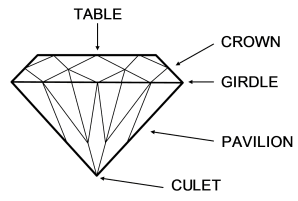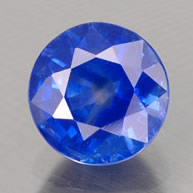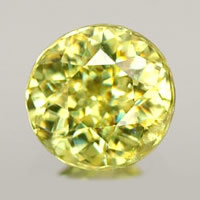Your Details
Your Details
|
Reviewed By Andreas Zabczyk
Gemstone Scintillation
Gem Crown Pavilion
Gemstone scintillation refers to the play of light within a gemstone. It is the sparkling effect that occurs when light interacts with the facets of a gemstone and reflects back to the viewer's eye. Scintillation is influenced by factors such as the cut, shape, and arrangement of facets within the gemstone. When a gemstone is well-cut and has proper proportions, it can exhibit a high level of scintillation, resulting in a dazzling display of brilliance and fire We have a huge selection of sparkling gemstones for sale. During the Renaissance there was intense interest in the science of optics. We see this trend in painters such as Van Eyck, whose work shows a keen sense of light and reflection. In the gemstone world this was a time when lapidaries began to conceive elaborate geometric faceting schemes to control and enhance the light coming from within a gemstone. Gems are fashioned in a variety of cutting styles that create planar surfaces called facets. The top facets form the crown and the bottom facets form the pavilion of the gemstone. The facets themselves are polygonal in shape. The crown and pavilion facets have different functions. Facets in the crown capture light whilst facets in the pavilion reflect light by total internal reflection. This light capturing and redirection makes a gem appear illuminated. There are several illumination effects produced that make a gemstone appealing. 
Brilliant-Cut Sapphire
The main illumination effects are known as brilliance, fire, and scintillation. Brilliance refers to the ability of a stone to redirect light to the eyes of an observer so that the gem's crown appears illuminated. The term fire or dispersion refers to the rainbow-like colors that are refracted from gemstone facets. Fire occurs because white light entering or exiting a stone is dispersed into its constituent colors. 
Sphene Dispersion
The effect of scintillation refers to flashes of light, white or colored, that are produced when the gem, the observer, or the illumination source moves. Scintillation is a dynamic and rich effect. Scintillation in gemstones has been broadly defined as the alternating display of reflections from the polished facets of a gemstone; in other words, the flashing or twinkling of light from a facet. Many people are confused about the difference between brilliance and scintillation. Brilliance is sometimes referred to as "internal luster" or "liveliness". It is the amount of light entering a stone that is returned to the eye of the viewer. It is in that brilliance that you see the color of the gem. The level of brilliance is dependent on the type of stone, its clarity and how it is cut. A stone that is not well cut and proportioned will "leak" light from the back of the stone. This results in dull or dark looking areas, called "areas of extinction", which can be seen when viewing the stone face up. A gem cut with a smooth, cone-shaped pavilion could display full brilliance, but would lack scintillation. Thus the use of small facets to create sparkle as the gem, light or eye is moved. In general, large gems require more facets; small gems typically have less, for tiny reflections cannot be individually distinguished by the eye (resulting in a blurred appearance). |
